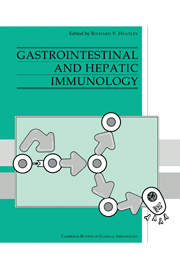Book contents
- Frontmatter
- Contents
- List of contributors
- Preface
- 1 Lymphoid cells and tissues of the gastrointestinal tract
- 2 Lymphocyte migration to the gut mucosa
- 3 Regulating factors affecting gut mucosal defence
- 4 Gastritis
- 5 The immunology of coeliac disease
- 6 Inflammatory bowel disease
- 7 Food intolerance and allergy
- 8 Gastrointestinal and liver involvement in primary immunodeficiency
- 9 Secondary immunodeficiency – the acquired immunodeficiency syndrome (AIDS)
- 10 Intestinal infections
- 11 Lymphomas
- 12 Small bowel transplantation
- 13 Clinical aspects of immunologically mediated intestinal diseases
- 14 Chronic active hepatitis
- 15 Primary biliary cirrhosis
- 16 Immunology and immunopathology of acute viral hepatitis
- 17 Immunology of liver transplantation
- 18 Clinical correlates with hepatic diseases
- Index
16 - Immunology and immunopathology of acute viral hepatitis
Published online by Cambridge University Press: 03 February 2010
- Frontmatter
- Contents
- List of contributors
- Preface
- 1 Lymphoid cells and tissues of the gastrointestinal tract
- 2 Lymphocyte migration to the gut mucosa
- 3 Regulating factors affecting gut mucosal defence
- 4 Gastritis
- 5 The immunology of coeliac disease
- 6 Inflammatory bowel disease
- 7 Food intolerance and allergy
- 8 Gastrointestinal and liver involvement in primary immunodeficiency
- 9 Secondary immunodeficiency – the acquired immunodeficiency syndrome (AIDS)
- 10 Intestinal infections
- 11 Lymphomas
- 12 Small bowel transplantation
- 13 Clinical aspects of immunologically mediated intestinal diseases
- 14 Chronic active hepatitis
- 15 Primary biliary cirrhosis
- 16 Immunology and immunopathology of acute viral hepatitis
- 17 Immunology of liver transplantation
- 18 Clinical correlates with hepatic diseases
- Index
Summary
Introduction
Five major hepatotrophic viruses causing acute or chronic viral hepatitis have been identified. The viruses causing types A to E have been extensively characterized; other viruses, including Epstein-Barr virus and cytomegalovirus may also cause hepatitis. A giant cell hepatitis, and fulminant hepatitis (Fagan et al., 1989; Phillips et al., 1991), for which viruses are being sought, are recognised. Although the molecular virology and serological response in viral hepatitis have been studied in depth, the immune response to hepatitis A to E remains complex. The immunobiology of type B hepatitis has been most widely studied.
Hepatitis A
Hepatitis A virus (HAV) has a similar particle size, capsid structure and genome organisation to other picornoviruses, but is sufficiently different to be classified as a genus within the picornovirus family. The genomes of several strains of HAV have been sequenced and found to be 7470–7478 nucleotides (nt) in length. Type A hepatitis is spread predominantly by the faecal-oral route, but parenteral transmission has been described. Clinical disease with jaundice is uncommon in infants and young children and the infection may pass unnoticed in this group. Severe hepatitis is correspondingly more common in older persons. In countries where there has been improvement in socio-economic conditions and sanitation, such as southern Europe and China, there has been an increase in the mean age of infection.
There is a high level of conservation of cDNA of human HAV strains at the nucleotide level, but PCR based partial sequencing of regions of HAV has revealed unexpected genetic diversity.
- Type
- Chapter
- Information
- Gastrointestinal and Hepatic Immunology , pp. 324 - 353Publisher: Cambridge University PressPrint publication year: 1994



